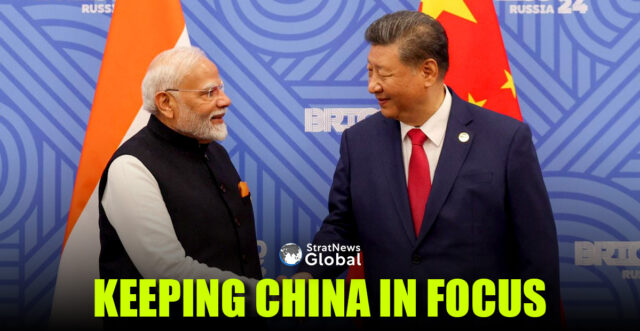Operation Sindoor And China
A month since Operation Sindoor was launched, much has been analysed about India signalling a shift in its strategic intent, drawing a new redline against Pakistan and teaching the perpetrators of terrorism a hard lesson. What has elicited limited discussion however is Pakistan’s total dependence on China for its military hardware. Pakistan will continue to be a nuisance for India, thanks chiefly due to China’s unwavering material support and diplomatic cover fire.
The devastating strikes against Pakistan-based terrorist groups and their backers and then critical military infrastructure may have imposed a dissuasive if not deterrent cost on the Pakistani military but India must not lose sight of the fact that China remains its primary adversary and will do its best to keep India busy with occasional bursts of tension on its western border. While Pakistan remains hostile, the real long-term threat is from China—militarily, economically and geopolitically.
India’s Two-Front Challenge
Five years ago, China tried to take advantage of India’s and the world’s pre-occupation with Covid and attempted to change the status quo on the Line of Actual Control (LAC). An immediate and resolute Indian response was a surprise for China. After over 50 months of negotiations a resolution—albeit temporary—of the border tension has been arrived at. The broader competition and even contest between India and China however remains and is only likely to exacerbate in coming years. China is likely to adopt a policy of keeping the border hot and active, short of conflict, to keep India tied down along the LAC. At the same time, it will speed up the process of arming Pakistan so that a two-front challenge, if not a two-front war for India will be a constant source of worry.
Pahalgam Ploy By Pak Army
There is no doubt that the Pahalgam massacre was a ploy to draw India into a conflict and enable the Pakistan army to partly regain its standing in the eyes of the citizens who have been increasingly mocking the military and its all-pervasive presence in the Pakistan polity.
By going beyond peripheral actions against terrorists and hitting the very epicentre of terrorism in Pakistani Punjab besides imposing long term costs such as keeping the Indus Water Treaty in abeyance, India has demonstrated its willingness to punish Pakistan but China and to some extent Turkiye, will ensure Pakistan regains some of the lost assets quickly in order to keep India engaged.
India Should Be On Its Own
India framed Operation Sindoor as a determined and focused response to a heinous act of terrorism but the world, taken in by Pakistan’s nuclear scare mongering, saw the short, swift Indian military action and Pakistan’s largely ineffective riposte as war between two nuclear armed neighbours and not as a counter-terrorism strategy.
None of the big global players, including the U.S., Russia and Quad partners such as Australia and Japan, stood unequivocally with India in complete contrast to China and Turkiye’s unconditional support to Pakistan during the four-day ‘war.’ This reality, while apparent in many ways over the past couple of years, has now been reinforced. India’s economy and military rise will be resented and opposed by both declining and aspiring powers as well as our smaller neighbours. The fact is India is alone, in war, in diplomacy and in the attempts to set narratives. This realisation must be internalised by every Indian.
China’s increasing forays in the Indian sub-continent and the proclivity of India’s neighbours to take advantage of this competition between India and China has been apparent for a couple of decades. It’s a game New Delhi has played with mixed results. Indian diplomacy will have to be nimbler and more creative to tackle China’s assertiveness in the region and find its own ways to keep relations with immediate neighbours on an even keel.
Need To Bolster Defence Ecosystem
Strengthening the country’s fledgling military-industrial ecosystem, improving efficiency in defence procurement, creating genuine IP-based indigenous defence products and encouraging cutting edge research and development in defence should become a top priority for India.
During Operation Sindoor, some of India’s home-grown systems have performed exceptionally well but some others have failed to deliver. The weaknesses must be identified, rectified and improved. There is no alternative to be self-reliant in defence but it should not come at the cost of military preparedness in the short run.
As Chief of Defence Staff (CDS) Gen Anil Chauhan has said in his recently released book: “To remain ahead of the curve Atmanirbharta initiative has provided our nation with a possible solution. We need to choose whether we would follow a ‘Technology Led’ or ‘Tactics Led’ force modernisation. With the technological development edge being with major powers, we as a nation are forced to adopt a follower approach wherein, we end up waiting for new technologies to crystallise and later are forced to chase the process of technological absorption, tactics development and even organisational re-orientation in an unplanned manner. It results in always being behind the curve.”
Therefore, he adds, a ‘Tactics Led’ approach would not only assure that we develop an asymmetric edge over our adversaries through indigenous solutions but also achieve the aim of setting up a self-reliant world-class defence ecosystem in our nation.”
Looking Ahead
China is already operating in the paradigm of system warfare—targeting command-and-control, networks and sensors. India must prepare to match or counter these capabilities. Chinese systems failed to protect Pakistan in Operation Sindoor. But conditions will not remain identical. By the time the next skirmish with Pakistan takes place—and take place it will—China would have supplied Rawalpindi with much improved weapons. India will have to be ready to meet and neutralise that challenge. The biggest beneficiary of a prolonged India-Pakistan conflict will no doubt be China. It is imperative therefore that India keeps its sights firmly on China’s actions and not get euphoric or complacent with the success of Operation Sindoor.
Nitin A. Gokhale is a media entrepreneur, one of South Asia's leading strategic affairs analyst and author of over a dozen books so far on military history, insurgencies and wars.
Starting his career in journalism in 1983, he has since led teams of journalists across media platforms.
A specialist in conflict coverage, Gokhale has covered the insurgencies in India’s North-East, the 1999 Kargil conflict and Sri Lanka’s Eelam War IV between 2006-2009.
Gokhale now travels across the globe to speak at seminars and conferences, and lecture at India’s premier defence colleges. He has founded three niche portals, Bharatshakti.in, stratnewsglobal.com and Interstellar.news.





